WNT and β-catenin signalling diseases and therapies
LRP6通过Wnt-β-catenin信号通路促进乳腺癌增殖、侵袭及转移
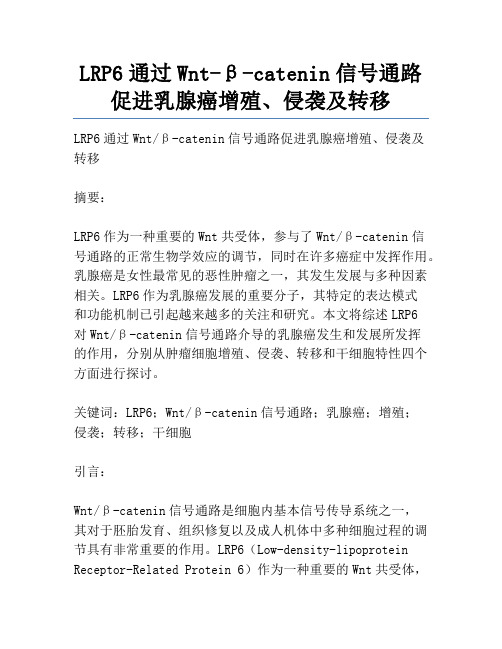
LRP6通过Wnt-β-catenin信号通路促进乳腺癌增殖、侵袭及转移LRP6通过Wnt/β-catenin信号通路促进乳腺癌增殖、侵袭及转移摘要:LRP6作为一种重要的Wnt共受体,参与了Wnt/β-catenin信号通路的正常生物学效应的调节,同时在许多癌症中发挥作用。
乳腺癌是女性最常见的恶性肿瘤之一,其发生发展与多种因素相关。
LRP6作为乳腺癌发展的重要分子,其特定的表达模式和功能机制已引起越来越多的关注和研究。
本文将综述LRP6对Wnt/β-catenin信号通路介导的乳腺癌发生和发展所发挥的作用,分别从肿瘤细胞增殖、侵袭、转移和干细胞特性四个方面进行探讨。
关键词:LRP6;Wnt/β-catenin信号通路;乳腺癌;增殖;侵袭;转移;干细胞引言:Wnt/β-catenin信号通路是细胞内基本信号传导系统之一,其对于胚胎发育、组织修复以及成人机体中多种细胞过程的调节具有非常重要的作用。
LRP6(Low-density-lipoprotein Receptor-Related Protein 6)作为一种重要的Wnt共受体,参与了Wnt/β-catenin信号通路的正常生物学效应的调节。
LRP6在肿瘤中发挥作用的研究表明,与多种癌症相关的Wnt/β-catenin信号通路的激活往往伴随着LRP6 的过度表达。
其中乳腺癌是女性最常见的恶性肿瘤之一,其发生发展与多种因素相关。
LRP6作为乳腺癌发展的重要分子,其特定的表达模式和功能机制已引起越来越多的关注和研究。
本文旨在阐明LRP6对Wnt/β-catenin信号通路介导的乳腺癌发生和发展所发挥的作用,分别从肿瘤细胞增殖、侵袭、转移和干细胞特性四个方面进行探讨。
一、LRP6在乳腺癌细胞中的表达模式在正常的人体组织中,LRP6的表达量通常较低。
然而在多种癌症中,包括乳腺癌在内,LRP6的表达显著上调。
在对40例原发性乳腺癌的组织病理学研究中发现,有87.5%的乳腺癌病人表现出LRP6过度表达的情况,其中高级别癌症的表达率更高(1)。
Wnt信号通路与阿尔茨海默病的关系
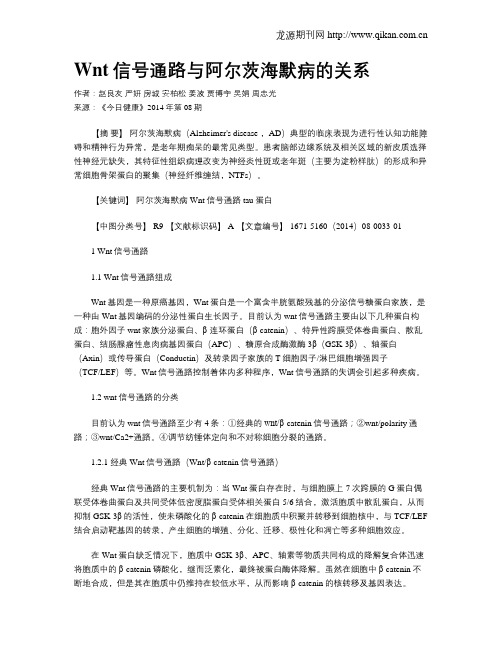
Wnt信号通路与阿尔茨海默病的关系作者:赵良友严妍房城安柏松姜波贾博宇吴娟周忠光来源:《今日健康》2014年第08期【摘要】阿尔茨海默病(Alzheimer's disease ,AD)典型的临床表现为进行性认知功能障碍和精神行为异常,是老年期痴呆的最常见类型。
患者脑部边缘系统及相关区域的新皮质选择性神经元缺失,其特征性组织病理改变为神经炎性斑或老年斑(主要为淀粉样肽)的形成和异常细胞骨架蛋白的聚集(神经纤维缠结,NTFs)。
【关键词】阿尔茨海默病 Wnt信号通路 tau蛋白【中图分类号】 R9 【文献标识码】 A 【文章编号】 1671-5160(2014)08-0033-011 Wnt信号通路1.1 Wnt信号通路组成Wnt基因是一种原癌基因,Wnt蛋白是一个富含半胱氨酸残基的分泌信号糖蛋白家族,是一种由Wnt基因编码的分泌性蛋白生长因子。
目前认为wnt信号通路主要由以下几种蛋白构成:胞外因子wnt家族分泌蛋白、β-连环蛋白(β-catenin)、特异性跨膜受体卷曲蛋白、散乱蛋白、结肠腺瘤性息肉病基因蛋白(APC)、糖原合成酶激酶3β(GSK-3β)、轴蛋白(Axin)或传导蛋白(Conductin)及转录因子家族的T细胞因子/淋巴细胞增强因子(TCF/LEF)等。
Wnt信号通路控制着体内多种程序,Wnt信号通路的失调会引起多种疾病。
1.2 wnt信号通路的分类目前认为wnt信号通路至少有4条:①经典的wnt/β-catenin信号通路;②wnt/polarity通路;③wnt/Ca2+通路。
④调节纺锤体定向和不对称细胞分裂的通路。
1.2.1 经典Wnt信号通路(Wnt/β-catenin信号通路)经典Wnt信号通路的主要机制为:当Wnt蛋白存在时,与细胞膜上7次跨膜的G蛋白偶联受体卷曲蛋白及共同受体低密度脂蛋白受体相关蛋白5/6结合,激活胞质中散乱蛋白,从而抑制GSK-3β的活性,使未磷酸化的β-catenin在细胞质中积聚并转移到细胞核中,与TCF/LEF 结合启动靶基因的转录,产生细胞的增殖、分化、迁移、极性化和凋亡等多种细胞效应。
细胞信号传导和癌症治疗的新途径
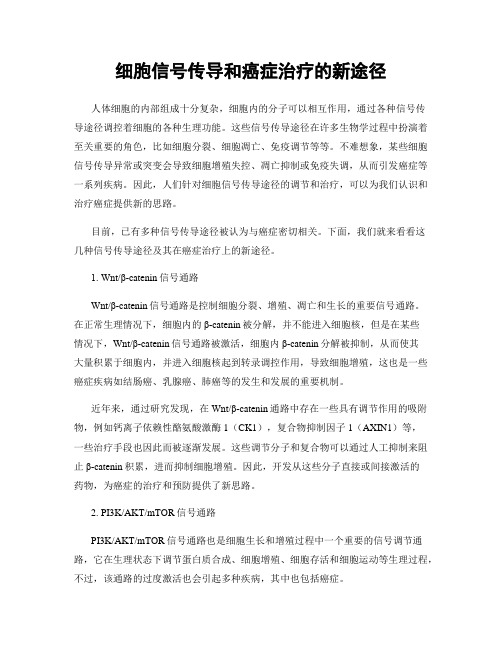
细胞信号传导和癌症治疗的新途径人体细胞的内部组成十分复杂,细胞内的分子可以相互作用,通过各种信号传导途径调控着细胞的各种生理功能。
这些信号传导途径在许多生物学过程中扮演着至关重要的角色,比如细胞分裂、细胞凋亡、免疫调节等等。
不难想象,某些细胞信号传导异常或突变会导致细胞增殖失控、凋亡抑制或免疫失调,从而引发癌症等一系列疾病。
因此,人们针对细胞信号传导途径的调节和治疗,可以为我们认识和治疗癌症提供新的思路。
目前,已有多种信号传导途径被认为与癌症密切相关。
下面,我们就来看看这几种信号传导途径及其在癌症治疗上的新途径。
1. Wnt/β-catenin信号通路Wnt/β-catenin信号通路是控制细胞分裂、增殖、凋亡和生长的重要信号通路。
在正常生理情况下,细胞内的β-catenin被分解,并不能进入细胞核,但是在某些情况下,Wnt/β-catenin信号通路被激活,细胞内β-catenin分解被抑制,从而使其大量积累于细胞内,并进入细胞核起到转录调控作用,导致细胞增殖,这也是一些癌症疾病如结肠癌、乳腺癌、肺癌等的发生和发展的重要机制。
近年来,通过研究发现,在Wnt/β-catenin通路中存在一些具有调节作用的吸附物,例如钙离子依赖性酪氨酸激酶1(CK1),复合物抑制因子1(AXIN1)等,一些治疗手段也因此而被逐渐发展。
这些调节分子和复合物可以通过人工抑制来阻止β-catenin积累,进而抑制细胞增殖。
因此,开发从这些分子直接或间接激活的药物,为癌症的治疗和预防提供了新思路。
2. PI3K/AKT/mTOR信号通路PI3K/AKT/mTOR信号通路也是细胞生长和增殖过程中一个重要的信号调节通路,它在生理状态下调节蛋白质合成、细胞增殖、细胞存活和细胞运动等生理过程,不过,该通路的过度激活也会引起多种疾病,其中也包括癌症。
对于该通路的调控方法,目前在癌症治疗方面发现了一些新途径,尤其是阿丝琴姆(ascomycin)等小分子抑制剂针对PI3K/AKT/mTOR的信号通路竞相开发。
黄曲霉毒素的研究进展
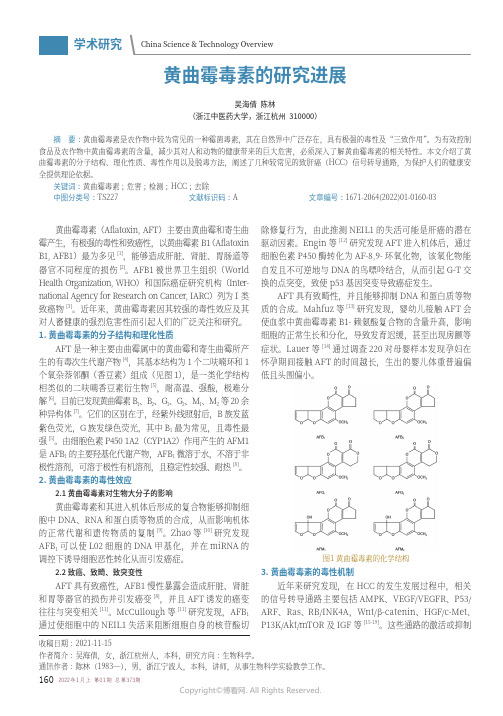
1602022年1月上 第01期 总第373期学术研究China Science & Technology Overview黄曲霉毒素(Afl atoxin, AFT)主要由黄曲霉和寄生曲霉产生,有极强的毒性和致癌性,以黄曲霉素B1(Afl atoxin B1, AFB1)最为多见[1],能够造成肝脏、肾脏、胃肠道等器官不同程度的损伤[2]。
AFB1被世界卫生组织(WorldHealth Organization, WHO)和国际癌症研究机构(Inter-national Agency for Research on Cancer , IARC)列为Ⅰ类致癌物[3]。
近年来,黄曲霉毒素因其较强的毒性效应及其对人畜健康的强烈危害性而引起人们的广泛关注和研究。
1.黄曲霉毒素的分子结构和理化性质AFT 是一种主要由曲霉属中的黄曲霉和寄生曲霉所产生的有毒次生代谢产物[4],其基本结构为1个二呋喃环和1个氧杂萘邻酮(香豆素)组成(见图1),是一类化学结构相类似的二呋喃香豆素衍生物[5],耐高温、强酸,极难分解[6]。
目前已发现黄曲霉素B 1、B 2、G 1、G 2、M 1、M 2等20余种异构体[7]。
它们的区别在于,经紫外线照射后,B 族发蓝紫色荧光,G 族发绿色荧光,其中B 1最为常见,且毒性最强[5]。
由细胞色素P450 1A2(CYP1A2)作用产生的AFM1是AFB 1的主要羟基化代谢产物,AFB 1微溶于水,不溶于非极性溶剂,可溶于极性有机溶剂,且稳定性较强、耐热[8]。
2.黄曲霉毒素的毒性效应2.1 黄曲霉毒素对生物大分子的影响黄曲霉毒素和其进入机体后形成的复合物能够抑制细胞中DNA、RNA 和蛋白质等物质的合成,从而影响机体的正常代谢和遗传物质的复制[9]。
Zhao 等[10]研究发现AFB 1可以使L02细胞的DNA 甲基化,并在miRNA 的调控下诱导细胞恶性转化从而引发癌症。
2.2 致癌、致畸、致突变性AFT 具有致癌性,AFB1慢性暴露会造成肝脏、肾脏和胃等器官的损伤并引发癌变[8],并且AFT 诱发的癌变往往与突变相关[11]。
Wnt信号通路在心血管系统中作用研究的进展
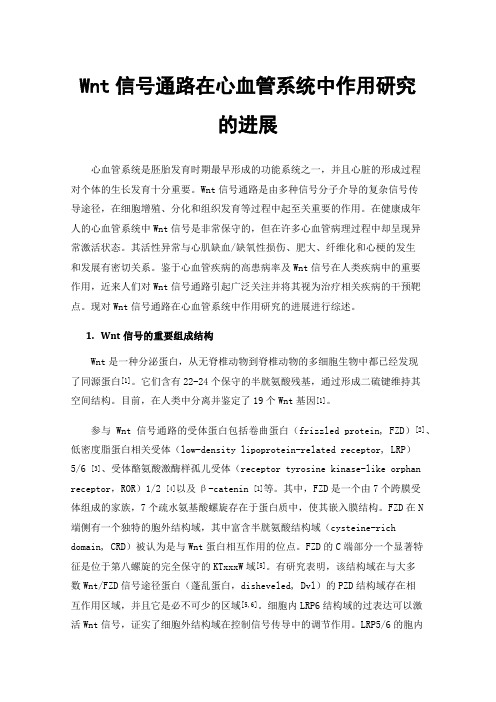
Wnt信号通路在心血管系统中作用研究的进展心血管系统是胚胎发育时期最早形成的功能系统之一,并且心脏的形成过程对个体的生长发育十分重要。
Wnt信号通路是由多种信号分子介导的复杂信号传导途径,在细胞增殖、分化和组织发育等过程中起至关重要的作用。
在健康成年人的心血管系统中Wnt信号是非常保守的,但在许多心血管病理过程中却呈现异常激活状态。
其活性异常与心肌缺血/缺氧性损伤、肥大、纤维化和心梗的发生和发展有密切关系。
鉴于心血管疾病的高患病率及Wnt信号在人类疾病中的重要作用,近来人们对Wnt信号通路引起广泛关注并将其视为治疗相关疾病的干预靶点。
现对Wnt信号通路在心血管系统中作用研究的进展进行综述。
1.Wnt信号的重要组成结构Wnt是一种分泌蛋白,从无脊椎动物到脊椎动物的多细胞生物中都已经发现了同源蛋白[1]。
它们含有22-24个保守的半胱氨酸残基,通过形成二硫键维持其空间结构。
目前,在人类中分离并鉴定了19个Wnt基因[1]。
参与Wnt信号通路的受体蛋白包括卷曲蛋白(frizzled protein, FZD)[2]、低密度脂蛋白相关受体(low-density lipoprotein-related receptor, LRP)5/6 [3]、受体酪氨酸激酶样孤儿受体(receptor tyrosine kinase-like orphan receptor,ROR)1/2 [4]以及β-catenin [1]等。
其中,FZD是一个由7个跨膜受体组成的家族,7个疏水氨基酸螺旋存在于蛋白质中,使其嵌入膜结构。
FZD在N端侧有一个独特的胞外结构域,其中富含半胱氨酸结构域(cysteine-rich domain, CRD)被认为是与Wnt蛋白相互作用的位点。
FZD的C端部分一个显著特征是位于第八螺旋的完全保守的KTxxxW域[5]。
有研究表明,该结构域在与大多数Wnt/FZD信号途径蛋白(蓬乱蛋白,disheveled, Dvl)的PZD结构域存在相互作用区域,并且它是必不可少的区域[5,6]。
Wntβ-catenin信号通路与骨肉瘤
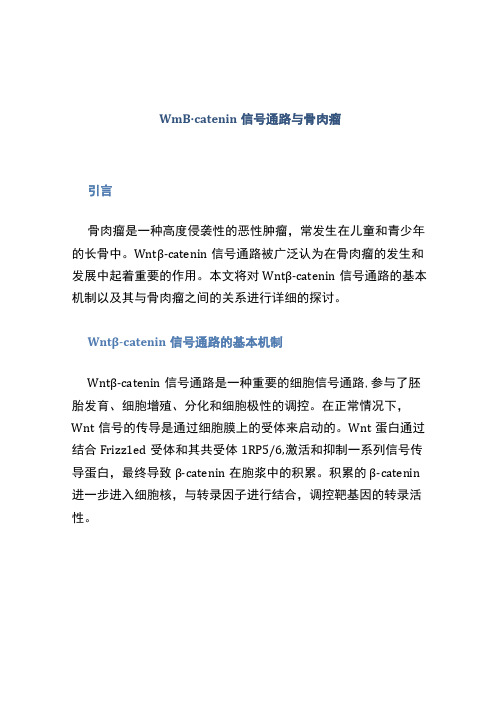
WmB∙catenin信号通路与骨肉瘤引言骨肉瘤是一种高度侵袭性的恶性肿瘤,常发生在儿童和青少年的长骨中。
Wntβ-catenin信号通路被广泛认为在骨肉瘤的发生和发展中起着重要的作用。
本文将对Wntβ-catenin信号通路的基本机制以及其与骨肉瘤之间的关系进行详细的探讨。
Wntβ-catenin信号通路的基本机制Wntβ-catenin信号通路是一种重要的细胞信号通路,参与了胚胎发育、细胞增殖、分化和细胞极性的调控。
在正常情况下,Wnt信号的传导是通过细胞膜上的受体来启动的。
Wnt蛋白通过结合Frizz1ed受体和其共受体1RP5/6,激活和抑制一系列信号传导蛋白,最终导致β-catenin在胞浆中的积累。
积累的β-catenin 进一步进入细胞核,与转录因子进行结合,调控靶基因的转录活性。
Wntβ-catenin信号通路与骨肉瘤的关系Wntβ∙catenin信号通路是骨肉瘤发生和发展的关键信号通路之一。
许多研究表明,Wnt信号通路的活化在骨肉瘤中起着重要的作用。
首先,一些研究发现骨肉瘤患者中Wnt信号通路的成员如Frizz1ed受体、1RP5/6和β-catenin的表达水平明显升高。
其次,Wnt信号通路的激活可以促进骨肉瘤细胞的增殖和侵袭能力,同时抑制细胞凋亡。
最后,抑制Wnt信号可以抑制骨肉瘤细胞的增殖和侵袭,甚至诱导细胞凋亡。
Wntβ-catenin信号通路在治疗骨肉瘤中的应用由于WntB∙catenin信号通路在骨肉瘤中的重要作用,研究人员开始探索利用该信号通路进行骨肉瘤的治疗。
一些研究发现,通过抑制Wnt信号通路的活化,可以抑制骨肉瘤细胞的增殖和侵袭能力,并诱导细胞凋亡。
目前,一些针对Wnt信号通路的靶向药物也已经进入临床试验,展现出一定的治疗潜力。
结论WntB∙catenin信号通路与骨肉瘤之间存在着密切的关系。
该信号通路的活化在骨肉瘤的发生和发展中起着重要的作用,而抑制该信号通路的活化则有望成为骨肉瘤治疗的新策略。
Wnt/β-catenin信号通路与发育和疾病研究进展
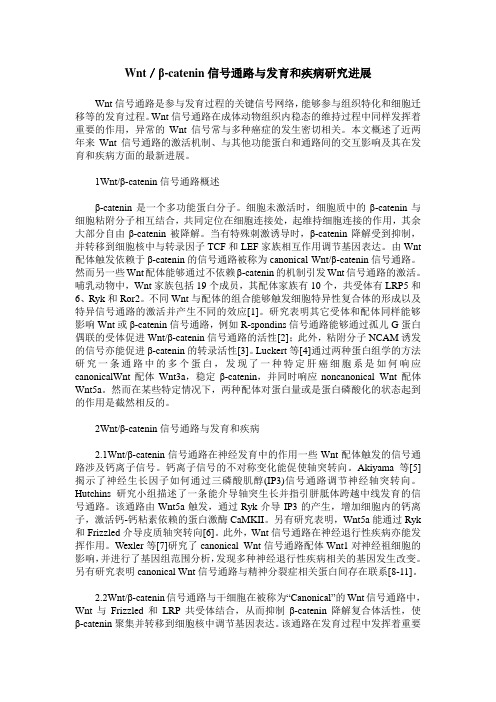
Wnt/β-catenin信号通路与发育和疾病研究进展Wnt信号通路是参与发育过程的关键信号网络,能够参与组织特化和细胞迁移等的发育过程。
Wnt信号通路在成体动物组织内稳态的维持过程中同样发挥着重要的作用,异常的Wnt信号常与多种癌症的发生密切相关。
本文概述了近两年来Wnt信号通路的激活机制、与其他功能蛋白和通路间的交互影响及其在发育和疾病方面的最新进展。
1Wnt/β-catenin信号通路概述β-catenin是一个多功能蛋白分子。
细胞未激活时,细胞质中的β-catenin与细胞粘附分子相互结合,共同定位在细胞连接处,起维持细胞连接的作用,其余大部分自由β-catenin被降解。
当有特殊刺激诱导时,β-catenin降解受到抑制,并转移到细胞核中与转录因子TCF和LEF家族相互作用调节基因表达。
由Wnt 配体触发依赖于β-catenin的信号通路被称为canonical Wnt/β-catenin信号通路。
然而另一些Wnt配体能够通过不依赖β-catenin的机制引发Wnt信号通路的激活。
哺乳动物中,Wnt家族包括19个成员,其配体家族有10个,共受体有LRP5和6、Ryk和Ror2。
不同Wnt与配体的组合能够触发细胞特异性复合体的形成以及特异信号通路的激活并产生不同的效应[1]。
研究表明其它受体和配体同样能够影响Wnt或β-catenin信号通路,例如R-spondins信号通路能够通过孤儿G蛋白偶联的受体促进Wnt/β-catenin信号通路的活性[2];此外,粘附分子NCAM诱发的信号亦能促进β-catenin的转录活性[3]。
Luckert等[4]通过两种蛋白组学的方法研究一条通路中的多个蛋白,发现了一种特定肝癌细胞系是如何响应canonicalWnt配体Wnt3a,稳定β-catenin,并同时响应noncanonical Wnt配体Wnt5a。
然而在某些特定情况下,两种配体对蛋白量或是蛋白磷酸化的状态起到的作用是截然相反的。
Wnt5a和β-catenin在子宫内膜腺癌中的表达及意义

Wnt5a和β-catenin在子宫内膜腺癌中的表达及意义Wnt5a和β-catenin在子宫内膜腺癌中的表达及意义简介子宫内膜腺癌是女性常见的一种恶性肿瘤,对妇女的生活和健康造成了严重的威胁。
Wnt5a和β-catenin是两个重要的信号通路蛋白,在多种癌症中具有重要的调节作用。
本文将探讨Wnt5a和β-catenin在子宫内膜腺癌中的表达及其意义。
Wnt5a信号通路Wnt5a是Wnt家族中的一个成员,它在维持组织和器官正常发育过程中发挥重要作用。
研究表明,在肿瘤中Wnt5a通路的异常表达与细胞极性重建、细胞增殖和浸润能力的改变等密切相关。
Wnt5a通过与其受体Frizzled结合,进而激活蛋白激酶C (PKC)和非经典β-吲哚酮酸(β-catenin)信号通路,从而促进细胞的迁移和浸润。
因此,Wnt5a通路在子宫内膜腺癌中的表达情况可能与其浸润和转移能力密切相关。
β-catenin信号通路β-catenin是一种在维持细胞黏附和极性方面起重要作用的蛋白。
在正常细胞中,β-catenin存在于细胞膜的细胞间连接位置。
然而,在致癌过程中,β-catenin的异常表达和功能失调导致其进入胞浆并进一步进入细胞核,在转录因子Tcf/Lef的结合下激活其下游靶基因的转录。
研究表明,β-catenin信号通路在调控细胞生长、增殖、分化和凋亡过程中发挥关键作用。
因此,β-catenin在子宫内膜腺癌中的表达情况也可能与肿瘤的发展和转移有关。
Wnt5a和β-catenin在子宫内膜腺癌中的表达及意义多项研究发现,Wnt5a在子宫内膜腺癌中的表达显著上调。
具体来说,Wnt5a的高表达与肿瘤的侵袭性和转移能力增强密切相关。
实验发现,Wnt5a能够促进细胞的迁移和侵袭,与肿瘤的浸润能力正相关,这可能是通过激活PKC和β-吲哚酮酸通路,从而增加细胞的浸润能力。
此外,研究发现Wnt5a还能够激活β-catenin信号通路,进一步促进肿瘤细胞的生长和分化。
Wntβ-catenin信号促进乳腺癌干细胞扩增的下游分子机理研究的开题报告
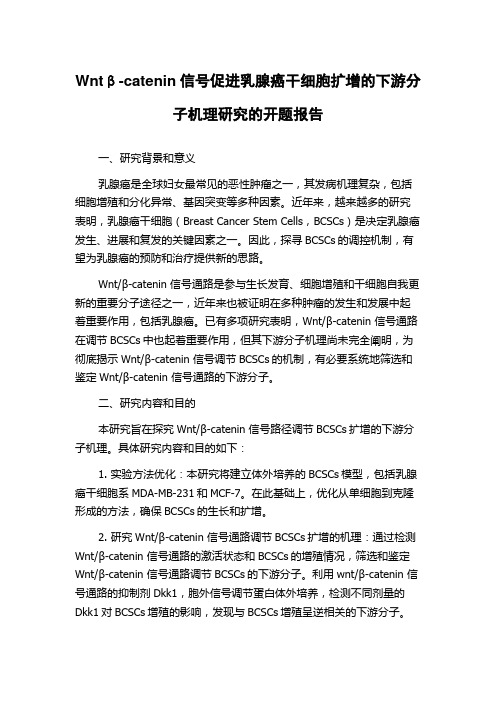
Wntβ-catenin信号促进乳腺癌干细胞扩增的下游分子机理研究的开题报告一、研究背景和意义乳腺癌是全球妇女最常见的恶性肿瘤之一,其发病机理复杂,包括细胞增殖和分化异常、基因突变等多种因素。
近年来,越来越多的研究表明,乳腺癌干细胞(Breast Cancer Stem Cells,BCSCs)是决定乳腺癌发生、进展和复发的关键因素之一。
因此,探寻BCSCs的调控机制,有望为乳腺癌的预防和治疗提供新的思路。
Wnt/β-catenin 信号通路是参与生长发育、细胞增殖和干细胞自我更新的重要分子途径之一,近年来也被证明在多种肿瘤的发生和发展中起着重要作用,包括乳腺癌。
已有多项研究表明,Wnt/β-catenin 信号通路在调节BCSCs中也起着重要作用,但其下游分子机理尚未完全阐明,为彻底揭示Wnt/β-catenin 信号调节BCSCs的机制,有必要系统地筛选和鉴定Wnt/β-catenin 信号通路的下游分子。
二、研究内容和目的本研究旨在探究Wnt/β-catenin 信号路径调节BCSCs扩增的下游分子机理。
具体研究内容和目的如下:1. 实验方法优化:本研究将建立体外培养的BCSCs模型,包括乳腺癌干细胞系MDA-MB-231和MCF-7。
在此基础上,优化从单细胞到克隆形成的方法,确保BCSCs的生长和扩增。
2. 研究Wnt/β-catenin 信号通路调节BCSCs扩增的机理:通过检测Wnt/β-catenin 信号通路的激活状态和BCSCs的增殖情况,筛选和鉴定Wnt/β-catenin 信号通路调节BCSCs的下游分子。
利用wnt/β-catenin 信号通路的抑制剂Dkk1,胞外信号调节蛋白体外培养,检测不同剂量的Dkk1对BCSCs增殖的影响,发现与BCSCs增殖呈逆相关的下游分子。
3. 验证候选下游分子的生物学功能:将筛选到的下游分子,体外表达,检测其对BCSCs的增殖影响,利用定量PCR、Western blot进行检测。
经典Wnt_通路与胶质瘤
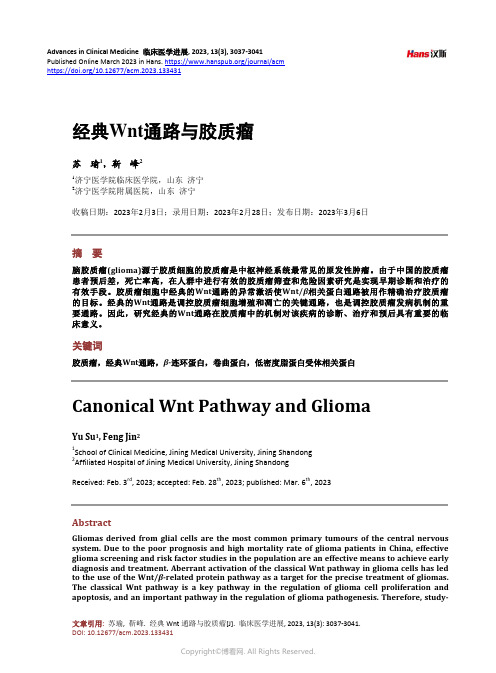
Advances in Clinical Medicine 临床医学进展, 2023, 13(3), 3037-3041 Published Online March 2023 in Hans. https:///journal/acm https:///10.12677/acm.2023.133431经典Wnt 通路与胶质瘤苏 瑜1,靳 峰21济宁医学院临床医学院,山东 济宁 2济宁医学院附属医院,山东 济宁收稿日期:2023年2月3日;录用日期:2023年2月28日;发布日期:2023年3月6日摘要 脑胶质瘤(glioma)源于胶质细胞的胶质瘤是中枢神经系统最常见的原发性肿瘤。
由于中国的胶质瘤患者预后差,死亡率高,在人群中进行有效的胶质瘤筛查和危险因素研究是实现早期诊断和治疗的有效手段。
胶质瘤细胞中经典的Wnt 通路的异常激活使Wnt/β相关蛋白通路被用作精确治疗胶质瘤的目标。
经典的Wnt 通路是调控胶质瘤细胞增殖和凋亡的关键通路,也是调控胶质瘤发病机制的重要通路。
因此,研究经典的Wnt 通路在胶质瘤中的机制对该疾病的诊断、治疗和预后具有重要的临床意义。
关键词胶质瘤,经典Wnt 通路,β-连环蛋白,卷曲蛋白,低密度脂蛋白受体相关蛋白Canonical Wnt Pathway and GliomaYu Su 1, Feng Jin 21School of Clinical Medicine, Jining Medical University, Jining Shandong 2Affiliated Hospital of Jining Medical University, Jining ShandongReceived: Feb. 3rd , 2023; accepted: Feb. 28th , 2023; published: Mar. 6th , 2023AbstractGliomas derived from glial cells are the most common primary tumours of the central nervous system. Due to the poor prognosis and high mortality rate of glioma patients in China, effective glioma screening and risk factor studies in the population are an effective means to achieve early diagnosis and treatment. Aberrant activation of the classical Wnt pathway in glioma cells has led to the use of the Wnt/β-related protein pathway as a target for the precise treatment of gliomas. The classical Wnt pathway is a key pathway in the regulation of glioma cell proliferation and apoptosis, and an important pathway in the regulation of glioma pathogenesis. Therefore, study-苏瑜,靳峰ing the mechanisms of the classical Wnt pathway in glioma has important clinical significance for the diagnosis, treatment and prognosis of this disease.KeywordsGlioma, Canonical Wnt Pathway, β-Catenin, FZD, Lrp Array Copyright © 2023 by author(s) and Hans Publishers Inc.This work is licensed under the Creative Commons Attribution International License (CC BY 4.0)./licenses/by/4.0/1. 引言脑胶质瘤(glioma)源于胶质细胞的胶质瘤是中枢神经系统最常见的原发性肿瘤[1]。
WNT_catenin信号通路表观重塑与人类癌症
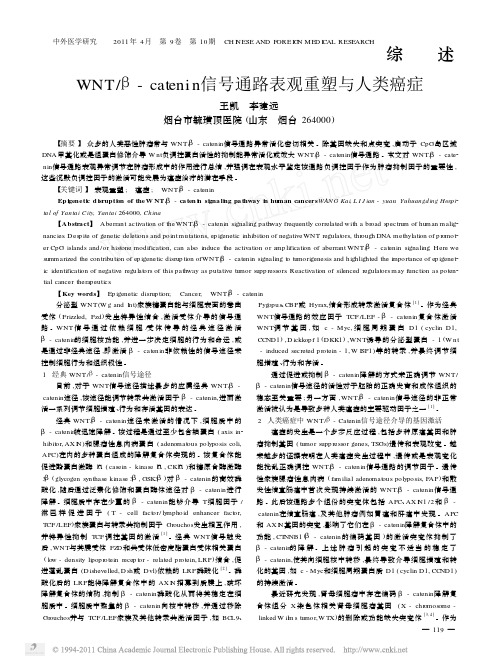
WNT/β-cateni n信号通路表观重塑与人类癌症王凯 李建远烟台市毓璜顶医院(山东 烟台264000)【摘要】 众多的人类恶性肿瘤常与WNT/β-catenin信号通路异常活化密切相关。
除基因缺失和点突变,启动子CpG岛区域DNA甲基化或是组蛋白修饰介导W nt负调控蛋白活性的抑制能异常活化或放大WNT/β-catenin信号通路。
本文对WNT/β-cate2 nin信号通路表观异常调节在肿瘤形成中的作用进行总结,并强调在表观水平鉴定该通路负调控因子作为肿瘤抑制因子的重要性,这些沉默负调控因子的激活可能发展为癌症治疗的潜在手段。
【关键词】 表观重塑; 癌症; WNT/β-cateninEp i geneti c d isrupti on of the W NT/β-ca ten i n si gna li n g pa thway i n hu man cancers WAN G Kai,L I J ian-yuan.Yuhuangding Hospi2 tal of Yantai C ity,Yantai264000,China【Abstract】 Aberrant activati on of the WNT/β-catenin signaling path way frequently correlated with a br oad s pectru m of hu man malig2 nancies.Des p ite of genetic deleti ons and pointmutati ons,ep igenetic inhibiti on of negativeWNT regulat ors,thr ough DNA methylati on of p r omot2 er CpG islands and/or hist one modificati on,can als o induce the activati on or a mp lificati on of aberrant WNT/β-catenin signaling.Here we su mmarized the contributi on of ep igenetic disrup ti on ofWNT/β-catenin signaling t o tu morigenesis and highlighted the i m portance of ep igenet2 ic identificati on of negative regulat ors of this pathway as putative tu mor supp ress ors.Reactivati on of silenced regulat ors may functi on as poten2 tial cancer therapeutics.【Key words】 Ep igenetic disrup ti on; Cancer; WNT/β-catenin 分泌型WNT(W g and I nt)家族糖蛋白能与细胞表面的卷曲受体(Frizzled,Fzd)发生特异性结合,激活受体介导的信号通路。
β-catenin-wnt中英文
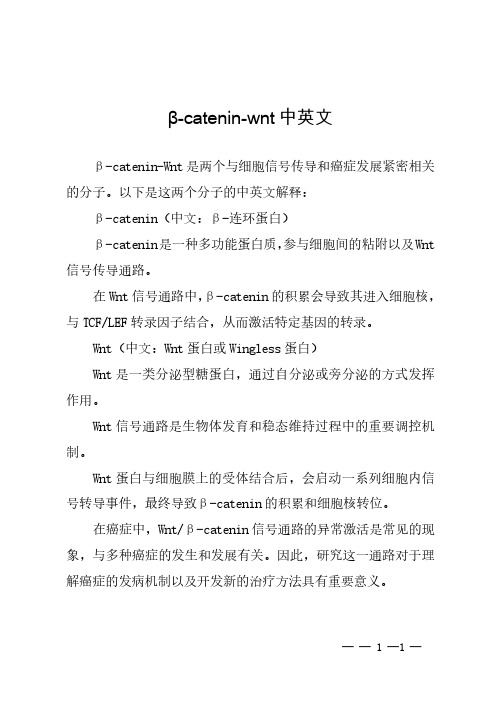
β-catenin-wnt中英文
β-catenin-Wnt是两个与细胞信号传导和癌症发展紧密相关的分子。
以下是这两个分子的中英文解释:
β-catenin(中文:β-连环蛋白)
β-catenin是一种多功能蛋白质,参与细胞间的粘附以及Wnt 信号传导通路。
在Wnt信号通路中,β-catenin的积累会导致其进入细胞核,与TCF/LEF转录因子结合,从而激活特定基因的转录。
Wnt(中文:Wnt蛋白或Wingless蛋白)
Wnt是一类分泌型糖蛋白,通过自分泌或旁分泌的方式发挥作用。
Wnt信号通路是生物体发育和稳态维持过程中的重要调控机制。
Wnt蛋白与细胞膜上的受体结合后,会启动一系列细胞内信号转导事件,最终导致β-catenin的积累和细胞核转位。
在癌症中,Wnt/β-catenin信号通路的异常激活是常见的现象,与多种癌症的发生和发展有关。
因此,研究这一通路对于理解癌症的发病机制以及开发新的治疗方法具有重要意义。
— — 1 —1 —。
Wnt信号通路及其与疾病的关系

14生物技术通报BiotechnologyBulletin2009年第11期葵、线虫和果蝇直到人类都存在的最基本的一条保守的信号通路途径。
Wnt信号通路是一条繁杂的信号网络,目前的研究认为至少有3个分支:经典Wnt通路(canonicalWntpathway),又叫Wnt/[3一catenin通路,该通路激活后导致细胞质内B.catenin的稳定和积累,然后B.catenin进入细胞核内激活靶基因表达旧o;Wnt/PCP通路(planarcellpolaritypathway)主要通过激活Dsh下游区、Rac、小GTP酶、Rho和Cde42等,从Wnt/p-catenin而激活c-junN端激酶JNK来发挥作用,参与细胞极性的建立和细胞骨架重排,调节细胞骨架的不对称分布和上皮细胞的协同极化…;Wnt/钙离子(Wnt/ca“)通路主要由wnt5a和wntll激活,可能通过G蛋白激活PLC(PhospholipaseC)和PKC(ProteinkinaseC),从而引起细胞内Ca“浓度增加和Ca“敏感信号成分的激活,以调节细胞运动和细胞粘着性H1,该通路能拮抗经典的Wnt通路(图1)。
W蚋CP喇削C矿1鼬nt|lNK圈1三条已知的Wnt信号通路目前看来,尽管这3条支路在胞内信号转导失活的方式不同,但是最初的步骤均是Wnt配体和Fzd受体的结合,各种Wnt配体和受体对不同分支有一定的特异性,但是,同一个配体在不同细胞里又可以激活不同的信号通路分支,这种特异性的控制机理目前还很不清楚。
Wnt基因的开放读码框架显示其编码的Wnt蛋白是分泌性糖蛋白,在进化过程中高度保守。
长度大约为350~400个氨基酸,起始为疏水信号序列。
其后连接一个信号肽酶识别位点,不含跨膜结构域,带有一段由23—24个半胱氨酸的几乎恒定的信号区。
Wnt蛋白分泌后可通过此区,与细胞表面特异性受体卷曲蛋白(frizzled,Fz)受体和辅助受体低密度脂蛋白受体相关蛋白(10Wdensitylipo-proteinreceptorrelatedproteinS/6,LRPS/6)家族结合,启动Wnt途径。
博士生论文发现了治疗肺纤维化的新途径
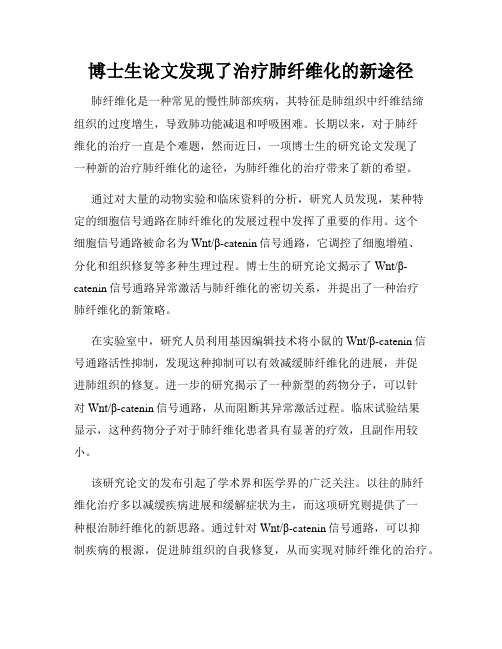
博士生论文发现了治疗肺纤维化的新途径肺纤维化是一种常见的慢性肺部疾病,其特征是肺组织中纤维结缔组织的过度增生,导致肺功能减退和呼吸困难。
长期以来,对于肺纤维化的治疗一直是个难题,然而近日,一项博士生的研究论文发现了一种新的治疗肺纤维化的途径,为肺纤维化的治疗带来了新的希望。
通过对大量的动物实验和临床资料的分析,研究人员发现,某种特定的细胞信号通路在肺纤维化的发展过程中发挥了重要的作用。
这个细胞信号通路被命名为Wnt/β-catenin信号通路,它调控了细胞增殖、分化和组织修复等多种生理过程。
博士生的研究论文揭示了Wnt/β-catenin信号通路异常激活与肺纤维化的密切关系,并提出了一种治疗肺纤维化的新策略。
在实验室中,研究人员利用基因编辑技术将小鼠的Wnt/β-catenin信号通路活性抑制,发现这种抑制可以有效减缓肺纤维化的进展,并促进肺组织的修复。
进一步的研究揭示了一种新型的药物分子,可以针对Wnt/β-catenin信号通路,从而阻断其异常激活过程。
临床试验结果显示,这种药物分子对于肺纤维化患者具有显著的疗效,且副作用较小。
该研究论文的发布引起了学术界和医学界的广泛关注。
以往的肺纤维化治疗多以减缓疾病进展和缓解症状为主,而这项研究则提供了一种根治肺纤维化的新思路。
通过针对Wnt/β-catenin信号通路,可以抑制疾病的根源,促进肺组织的自我修复,从而实现对肺纤维化的治疗。
不过,这项研究还存在一些问题和挑战。
首先,Wnt/β-catenin信号通路在人体内的具体调控机制还需深入研究。
其次,该药物分子的药理作用、毒副作用以及治疗效果的长期观察仍需要进一步研究。
此外,对于不同亚型和临床分期的肺纤维化患者,该治疗策略的差异性疗效和个体化治疗的问题也需要解决。
总之,博士生论文的发现为肺纤维化的治疗带来了新的希望。
Wnt/β-catenin信号通路作为一种治疗靶点,为肺纤维化的根源治疗提供了新的思路。
Wntβ-Catenin信号通路在系统性硬化症小鼠中介导周细胞功能紊乱的作用演示课件

周细胞功能紊乱机制探讨
Wntβ-Catenin信号通路激活
在硬化小鼠皮肤组织中,Wntβ-Catenin信号通路被激活,导致β-Catenin在周细胞核内累积,进而调控周细胞的基 因表达和功能。
周细胞外基质重构
Wntβ-Catenin信号通路激活后,周细胞分泌多种基质金属蛋白酶(MMPs)和整合素等分子,参与细胞外基质的重 构和硬化过程。
β-Catenin功能
作为Wnt信号通路的关键转录因子,进入细胞核后与TCF/LEF家族转录因子结合 ,调控靶基因的转录。
Wntβ-Catenin信号通路传导机制
经典Wnt信号通路
当Wnt蛋白与细胞膜上的Frizzled受体和LRP5/6辅助受体结合时,激活Dsh蛋白,抑制GSK3β活性, 导致β-Catenin在细胞质中累积并进入细胞核,与TCF/LEF结合启动靶基因转录。
周细胞功能紊乱与Wntβ-Catenin信 号通路的关系:进一步研究发现,周 细胞功能紊乱与Wntβ-Catenin信号 通路的异常激活密切相关。通过抑制 该通路的活性,可以改善周细胞的功 能状态,减轻系统性硬化症的症状。
潜在治疗靶点的发现:本研究还发现 了一些与Wntβ-Catenin信号通路相 关的关键分子,这些分子可能成为治 疗系统性硬化症的潜在靶点。针对这 些靶点的药物设计和研发,有望为系 统性硬化症的治疗提供新的思路和方 法。
目录
• 周细胞功能紊乱表型观察及机制探讨 • Wntβ-Catenin信号通路对周细胞功能
紊乱影响研究 • 总结与展望
01
引言
系统性硬化症概述
1 2
系统性硬化症定义
系统性硬化症是一种罕见的结缔组织病,其特征 为皮肤变硬、僵硬和厚实,可能伴随内脏器官的 受累。
b-catenin第675位氨基酸的磷酸化__解释说明以及概述
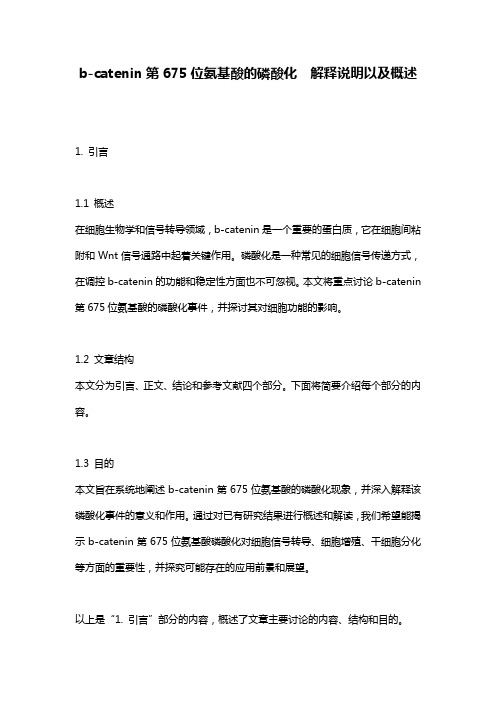
b-catenin第675位氨基酸的磷酸化解释说明以及概述1. 引言1.1 概述在细胞生物学和信号转导领域,b-catenin是一个重要的蛋白质,它在细胞间粘附和Wnt信号通路中起着关键作用。
磷酸化是一种常见的细胞信号传递方式,在调控b-catenin的功能和稳定性方面也不可忽视。
本文将重点讨论b-catenin 第675位氨基酸的磷酸化事件,并探讨其对细胞功能的影响。
1.2 文章结构本文分为引言、正文、结论和参考文献四个部分。
下面将简要介绍每个部分的内容。
1.3 目的本文旨在系统地阐述b-catenin第675位氨基酸的磷酸化现象,并深入解释该磷酸化事件的意义和作用。
通过对已有研究结果进行概述和解读,我们希望能揭示b-catenin第675位氨基酸磷酸化对细胞信号转导、细胞增殖、干细胞分化等方面的重要性,并探究可能存在的应用前景和展望。
以上是“1. 引言”部分的内容,概述了文章主要讨论的内容、结构和目的。
2. 正文:2.1 b-catenin的功能和调控机制:b-catenin是一种细胞间连接蛋白,它在细胞黏附、信号转导以及胚胎发育中发挥重要作用。
作为Wnt信号通路的核心成员,b-catenin在该通路中起着关键的调节功能。
在没有Wnt信号时,b-catenin通常会被细胞质内蛋白复合体(APC、Axin和GSK-3β)引起其磷酸化并标记为降解。
而当受到Wnt信号激活后,b-catenin逃脱蛋白复合物的调控,并进入细胞核,在那里与转录因子联合并激活目标基因的表达。
2.2 磷酸化在细胞信号转导中的作用:磷酸化是一种广泛存在于生物体内的翻译后修饰, 在细胞信号转导中起着重要作用。
通过添加一个磷酸基团到特定氨基酸上,可以改变该蛋白质分子的构象和活性。
对于b-catenin来说,磷酸化状态直接影响了其稳定性和亚细胞定位,从而调节了其在Wnt信号通路中的活性。
2.3 b-catenin第675位氨基酸的重要性:b-catenin在其C端拥有许多潜在的磷酸化位点,其中第675位氨基酸就是一个关键的位置。
Wnt2β-catenin信号通路在食管鳞癌发生发展中作用的研究的开题报告
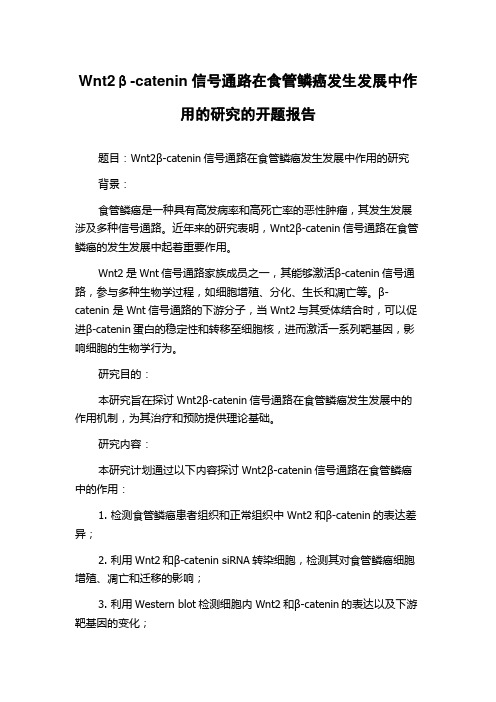
Wnt2β-catenin信号通路在食管鳞癌发生发展中作用的研究的开题报告题目:Wnt2β-catenin信号通路在食管鳞癌发生发展中作用的研究背景:食管鳞癌是一种具有高发病率和高死亡率的恶性肿瘤,其发生发展涉及多种信号通路。
近年来的研究表明,Wnt2β-catenin信号通路在食管鳞癌的发生发展中起着重要作用。
Wnt2是Wnt信号通路家族成员之一,其能够激活β-catenin信号通路,参与多种生物学过程,如细胞增殖、分化、生长和凋亡等。
β-catenin 是Wnt信号通路的下游分子,当Wnt2与其受体结合时,可以促进β-catenin蛋白的稳定性和转移至细胞核,进而激活一系列靶基因,影响细胞的生物学行为。
研究目的:本研究旨在探讨Wnt2β-catenin信号通路在食管鳞癌发生发展中的作用机制,为其治疗和预防提供理论基础。
研究内容:本研究计划通过以下内容探讨Wnt2β-catenin信号通路在食管鳞癌中的作用:1. 检测食管鳞癌患者组织和正常组织中Wnt2和β-catenin的表达差异;2. 利用Wnt2和β-catenin siRNA转染细胞,检测其对食管鳞癌细胞增殖、凋亡和迁移的影响;3. 利用Western blot检测细胞内Wnt2和β-catenin的表达以及下游靶基因的变化;4. 通过体内实验验证Wnt2β-catenin信号通路的促癌作用。
预期结果:本研究预计得出以下结论:1. Wnt2和β-catenin在食管鳞癌组织中的表达会显著升高;2. Wnt2和β-catenin siRNA转染可显著抑制食管鳞癌细胞的增殖、凋亡和迁移;3. Wnt2和β-catenin通过上调c-Myc和cyclin D1等基因表达对食管鳞癌发生发展具有促进作用;4. Wnt2β-catenin信号通路在体内实验证实具有促癌作用。
意义:本研究拟为食管鳞癌的治疗和预防提供新的治疗靶点,以促进对该疾病的深入了解,并为开发针对该信号通路的治疗手段提供理论依据。
Wnt信号通路和中枢神经系统疾病的研究进展
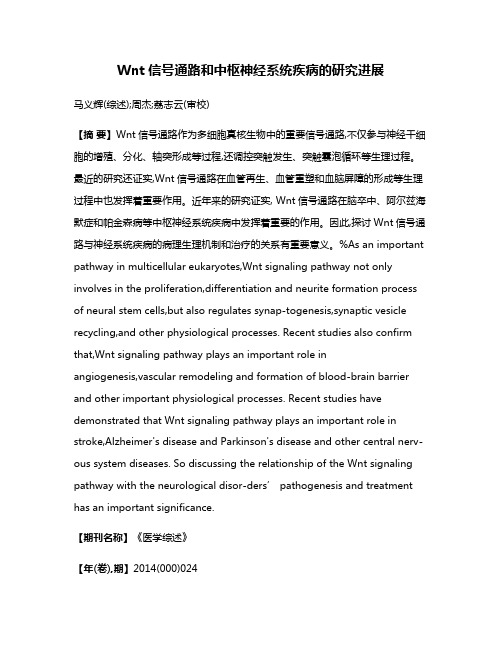
Wnt信号通路和中枢神经系统疾病的研究进展马义辉(综述);周杰;荔志云(审校)【摘要】Wnt信号通路作为多细胞真核生物中的重要信号通路,不仅参与神经干细胞的增殖、分化、轴突形成等过程,还调控突触发生、突触囊泡循环等生理过程。
最近的研究还证实,Wnt信号通路在血管再生、血管重塑和血脑屏障的形成等生理过程中也发挥着重要作用。
近年来的研究证实, Wnt信号通路在脑卒中、阿尔兹海默症和帕金森病等中枢神经系统疾病中发挥着重要的作用。
因此,探讨Wnt信号通路与神经系统疾病的病理生理机制和治疗的关系有重要意义。
%As an important pathway in multicellular eukaryotes,Wnt signaling pathway not only involves in the proliferation,differentiation and neurite formation process of neural stem cells,but also regulates synap-togenesis,synaptic vesicle recycling,and other physiological processes. Recent studies also confirm that,Wnt signaling pathway plays an important role in angiogenesis,vascular remodeling and formation of blood-brain barrier and other important physiological processes. Recent studies have demonstrated that Wnt signaling pathway plays an important role in stroke,Alzheimer's disease and Parkinson's disease and other central nerv-ous system diseases. So discussing the relationship of the Wnt signaling pathway with the neurological disor-ders’ pathogenesis and treatment has an important significance.【期刊名称】《医学综述》【年(卷),期】2014(000)024【总页数】3页(P4450-4452)【关键词】Wnt;信号通路;中枢神经系统【作者】马义辉(综述);周杰;荔志云(审校)【作者单位】兰州军区兰州总医院神经外科,兰州730050;兰州军区兰州总医院神经外科,兰州730050;兰州军区兰州总医院神经外科,兰州730050【正文语种】中文【中图分类】R741.02Wnt基因是从小鼠乳腺癌中克隆出的一种原癌基因。
抗肿瘤新化合物盐霉素杀伤肿瘤细胞的作用机制
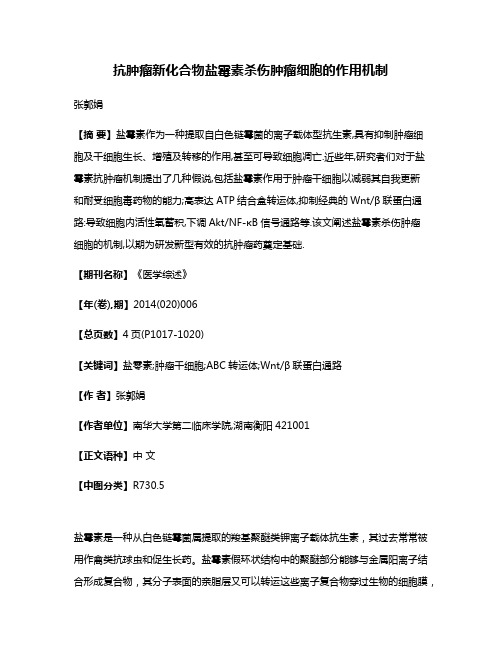
抗肿瘤新化合物盐霉素杀伤肿瘤细胞的作用机制张郭娟【摘要】盐霉素作为一种提取自白色链霉菌的离子载体型抗生素,具有抑制肿瘤细胞及干细胞生长、增殖及转移的作用,甚至可导致细胞凋亡.近些年,研究者们对于盐霉素抗肿瘤机制提出了几种假说,包括盐霉素作用于肿瘤干细胞以减弱其自我更新和耐受细胞毒药物的能力;高表达ATP结合盒转运体,抑制经典的Wnt/β联蛋白通路:导致细胞内活性氧蓄积,下调Akt/NF-κB信号通路等.该文阐述盐霉素杀伤肿瘤细胞的机制,以期为研发新型有效的抗肿瘤药奠定基础.【期刊名称】《医学综述》【年(卷),期】2014(020)006【总页数】4页(P1017-1020)【关键词】盐零素;肿瘤干细胞;ABC转运体;Wnt/β联蛋白通路【作者】张郭娟【作者单位】南华大学第二临床学院,湖南衡阳421001【正文语种】中文【中图分类】R730.5盐霉素是一种从白色链霉菌属提取的羧基聚醚类钾离子载体抗生素,其过去常常被用作禽类抗球虫和促生长药。
盐霉素假环状结构中的聚醚部分能够与金属阳离子结合形成复合物,其分子表面的亲脂层又可以转运这些离子复合物穿过生物的细胞膜,使得盐霉素具有杀死革兰阳性菌和抗禽类球虫病的作用[1]。
在一次高通量筛选实验中发现,盐霉素能够选择性靶向杀伤乳腺癌干细胞,并能抑制其在体内的生长与转移[2]。
另外,盐霉素对肺癌、子宫内膜癌、胃癌等肿瘤细胞也具有杀伤作用[3-5]。
尽管人们对盐霉素抗肿瘤机制还不完全了解,但研究者们在近几年的研究工作中提出了以下几种机制。
1 盐霉素与肿瘤干细胞肿瘤干细胞(cancer stem cells,CSCs)是一种存在于肿瘤的特殊亚群细胞,其拥有自我更新和分化成肿瘤细胞的能力,因此能够使肿瘤产生恶性异质性细胞系。
由于其特殊的生物学活性,存在于肿瘤中的CSCs可以耐受常规化疗药物、靶向治疗药物以及放射治疗,这使得肿瘤在经过多种治疗后仍然能够存活并发生转移[6]。
- 1、下载文档前请自行甄别文档内容的完整性,平台不提供额外的编辑、内容补充、找答案等附加服务。
- 2、"仅部分预览"的文档,不可在线预览部分如存在完整性等问题,可反馈申请退款(可完整预览的文档不适用该条件!)。
- 3、如文档侵犯您的权益,请联系客服反馈,我们会尽快为您处理(人工客服工作时间:9:00-18:30)。
WNTs are secreted cysteine-rich glycoproteins that act as short-range ligands to locally activate receptor-mediated signalling pathways.Their functions have been the subject of investigation for more than 20 years. Our present knowledge has come from genetic studies in Drosophila mela noga ster,mouse,zebrafish and Caenorhabditis elegans,as well as biochemical and cell biological studies using Xenopus laevis,sea urchin, chicken embryos and mammalian cultured cells1,2.One conclusion from this work is that WNTs seem to acti-vate more than one type of signalling pathway3.This is perhaps to be expected given that there are 19 members of the WNT protein family in mammals alone,which are expressed in spatially restricted and dynamic pat-terns in embryos and in adults.The best understood pathway activates the nuclear functions ofβ-catenin, leading to changes in gene expression that influence cell proliferation and survival,as well as cell fate.By contrast, some WNTs seem to activate β-catenin-independent pathways,generally leading to changes in cell movement and behaviour.Despite considerable progress in investigating the mechanisms of WNT signalling pathways and their roles in development,it is only recently that studies have emerged that implicate WNT signalling in diseases and clinical conditions other than cancer.In an effort to provide an initial overview of these new studies,our main goal in the present review is to emphasize the unexpected diversity in medical conditions that involve altered WNT signalling (TABLE 1).Another goal is to highlight recent evidence that altering WNT signalling might be therapeutic in various clinical contexts and in the development of stem-cell-based therapies.Finally,given the emerging involvement of WNT signalling in myriad disease processes,we hope that readers who might wish to initiate their own WNT projects will find useful the brief summary of WNT online and experimental resources that we have included.WNT and β-catenin signalling pathwaysβ-catenin-dependent WNT signalling.The best under-stood WNT signalling pathway — the WNT/β-catenin pathway (FIG.1)— has been characterized by a combina-tion of genetics and biochemistry.A core set of proteins and an ever-growing list of proteins that modify their function have been identified in this way,as thoroughly reviewed elsewhere4,5.In the absence of WNT ligands,β-catenin is recruited into a ‘destruction complex’that contains adenomatous polyposis coli (APC) and AXIN, which facilitate the phosphorylation ofβ-catenin by casein kinase 1 (CK1) and then glycogen synthase kinase 3 (GSK3).This leads to the ubiquitylation and proteasomal degradation ofβ-catenin.In the nucleus,WNT AND β-CATENIN SIGNALLING:DISEASES AND THERAPIESRandall T.Moon,Aimee D.Kohn,Giancarlo V.De Ferrari and Ajamete KaykasAbstract | WNT signalling has been studied primarily in developing embryos, in which cellsrespond to WNT s in a context-dependent manner through changes in survival and proliferation,cell fate and movement. But WNT s also have important functions in adults, and aberrant signallingby WNT pathways is linked to a range of diseases, most notably cancer. What is the full rangeof diseases that involve WNT pathways? Can inhibition of WNT signalling form the basis of aneffective therapy for some cancers? Could activation of WNT signalling provide new therapiesfor other clinical conditions? Finally, on the basis of recent experiments, might WNT s normallyparticipate in self-renewal, proliferation or differentiation of stem cells? If so, altering WNTsignalling might be beneficial to the use of stem cells for therapeutic means.Howard Hughes MedicalInstitute,Department ofPharmacology,and theCenter for DevelopmentalBiology,University ofWashington School ofMedicine,Seattle,Washington 98195,USA.Correspondence to R.T.M.e-mail:rtmoon@doi:10.1038/nrg1427tumour-suppressor roles,in other cancers such as melanoma there is evidence that WNT5A and WNT11 might act through the WNT/calcium path-way to promote increased cell motility and invasive-ness,paving the way for future studies on the role of WNT signalling in metastasis 22,23.WNT1 and the neurodevelopmental hypothesis of schiz-ophrenia.Most WNTs and FZ receptors are expressed during development of the central nervous system,and many are expressed in the adult brain,indicating that future reports might reveal the roles of WNT signalling in the adult brain.It has been proposed that increased expression of WNT1might lead to altered cell adhesion,synaptic rearrangement and plasticity in the brains of people with schizophrenia 24,with the caveat that elevated expression of WNT ligand does not ensure elevated WNT signalling,given the diversity of WNT pathway inhibitors.However,consistent with the possible involve-ment of WNT signalling in schizophrenia,it has recently been reported that SNPs in FZ3 are associated with susceptibility to schizophrenia 25,whereas others have suggested that GSK3 activity is altered in schizophrenia 26.Similarly,deletion of Dsh1/Dvl1 in mice produces behavioural defects 27,further linking the WNT pathway to the modulation of brain activity.It remains unclear,but worthy of future studies,whether WNT signalling is actually altered in individuals with psychiatric condi-tions and whether this is mechanistically linked to the symptoms.sFRP3 and osteoarthritis.Osteoarthritis is a degenerative disease of the joints,characterized by cartilage deteriora-tion.A recent study 28has found a SNP that is associated with osteoarthritis in females.This polymorphism is found in secreted Frizzled-related protein 3 (sFRP3),which is a secreted antagonist of WNTs.The polymor-phism reduces the ability of sFRP3 to antagonize WNT signalling,indicating that WNT signalling might be elevated in osteoarthritis.Altered function of Frizzled and LRP5/6Loss-of-function mutations in FZ4 and LRP5 are linked to FEVR.Considerable evidence points to a role for WNT signalling in vascular development,including the identification of vascular endothelial growth factor (VEGF ) as a direct target gene of β-catenin 29.Familial exudative vitreoretinopathy (FEVR ) is an inherited disorder of the retinal vasculature in which peripheral capillaries fail to grow,resulting in compen-satory neovascularization,leakage and bleeding,scar-ring and ultimately blindness.Although genetically heterogeneous,positional cloning of FEVR loci has revealed that loss-of-function mutations in the putative WNT receptor FZ4,and the co-receptor LRP5,underlie many cases of FEVR 30–33.Consistent with some FZ4mutations acting in a dominant manner,one mutation encodes a truncated protein that acts in a dominant–negative manner to oligomerize with wild-type FZ receptors,and to trap them in the endoplasmic reticu-lum 34.Nonetheless,many questions remain.Forabnormal testicular vasculature and their testos-terone synthesis is inhibited.Through the analysis of cells cultured in vitro ,the authors found that WNT4interferes with the functional synergy between β-catenin and steroidogenic factor 1,and reduces recruitment of β-catenin to the steroidogenic acute regulatory protein promoter.Although the mecha-nisms remain unclear,the authors do not discount the possibility that WNT4 antagonism of β-catenin func-tion might be a result of WNT4 acting through the WNT/calcium pathway.In summary,the authors suggest that WNT4 acts as an anti-male factor by interfering with β-catenin functions.WNT4 and renal development and disease.WNT4 is also linked to organ formation and disease.In the mouse,Wnt4and Wnt11are involved in kidney devel-opment,as revealed by analysis of knockout mice 15.Although several additional WNTs might function in the kidney,a key role for Wnt4in RENAL TUBULE formation is clear.Terada et al.16used a rat model of acute renal failure in which renal arteries were occluded to show that Wnt4RNA and protein are significantly elevated in tubules within hours after induced ISCHAEMIA .So,the recovery from injury might involve WNT-dependent processes that in some respects mirror normal develop-mental processes and pathways.Similarly,ligation of a single URETER results in tubular damage followed by a repair process in which WNT4 expression is elevated,which in turn activates expression of C-type natriuretic peptide that regulates fluid and electrolyte homeostasis and inhibits FIBROSIS 17.Finally,WNT and β-catenin signalling might be involved in polycystic kidney disease (PKD ).The poly-cystic kidney disease 1 (PKD1) gene,which is often mutated in PKD,is a direct target of β-catenin/TCF 18.Interestingly,the level of PKD1 expression might be important in PKD,as both elevation and reduction in expression have been linked to the disease.Consistent with these data,elevated expression of Wnt4has been reported in polycystic kidneys in mice,and transgenic mice that overexpress active forms of β-catenin develop PKD 18.WNT5a — A tumour-suppressor gene and a modula-tor of metastasis.Several lines of evidence support the idea that Wnt5a might be a tumour-suppressor gene.For example,loss of Wnt5a in C57MG mammary epithelial cells promotes a phenotypic transformation that resembles activation of β-catenin signalling 19.In a uroepithelial cell line,a chromosomal deficiency that removes Wnt5a results in a transformation that can be blocked by overexpression of Wnt5a 20.Mice that are hemizygous for Wnt5a develop myeloid leukaemia and B-cell lymphomas,and WNT5A is deleted or its expression is reduced in most patients with compara-ble cancers 21.Although the pathway that is activated by WNT5A has not been clearly identified in most of these studies,the data of Liang et al.21support a role for WNT5A as a tumour suppressor that works through WNT/calcium signalling.Independent ofRENAL TUBULESThe kidney contains many units known as nephrons,which contain (renal) tubules that are involved in filtering the blood.ISCHAEMIAReduced flow of oxygenated blood to organs in response to blockage in an artery.URETERA tube leading from the kidney to the bladder.FIBROSISFormation of fibrous tissue during a repair process.mutations in the amino terminal phosphorylation sites of β-catenin,and loss-of-function mutations in AXIN,also activate β-catenin signalling and are linked to can-cer 43–45.Interestingly,in non-small-cell lung cancer,DSH/DVL genes are overexpressed,and small interfer-ing RNAs (siRNA S) that reduce their expression inhibit growth 47.Finally,β-catenin signalling might,in some circumstances,be required for the maintenance of the transformed state 48–50,indicating that therapies that tar-get this pathway might be successful.Intriguingly,despite the observation that muta-tions in the β-catenin pathway generally activate the pathway downstream of WNT,and usually at the level of the destruction complex,recent evidence indicates that epigenetic inactivation of sFRP genes occurs early in colorectal cancer,and restoring sFRP expression attenuates activation of the β-catenin pathway 44,51.These data indicate continuing roles for WNT ligands in some cancers,even those in which downstream components are mutated.AXIN2,familial tooth agenesis and colon cancer.Effects of mutant AXIN2/Conductin,a component of the β-catenin degradation complex that is related to AXIN,confirm that activated β-catenin signalling is linked to defects in development and to cancer.Specifically,WNT signalling genes are normally expressed during tooth dev-elopment,and Lef1knockout mice have tooth defects 52;consequently,tooth defects might be expected in humans with mutations in the WNT pathway.Indeed,a Finnish family with severe tooth agenesis and with a his-tory of colorectal cancer was studied recently;positional cloning identified mutations in AXIN253.This study further supports the conclusion that β-catenin sig-nalling has normal roles in several organs,including the gut and teeth,and that mutations in components of this pathway can have phenotypic consequences in several unrelated structures.Mutations linked to tuberous sclerosis activate β-catenin signalling.Even mutations in genes that modulate β-catenin signalling without any apparent link to WNT ligands affect cell proliferation.Mutations in the tuber-ous sclerosis complex (TSC) genes Tsc1or Tsc2,which encode novel proteins that associate to form a complex,are linked to the disease tuberous sclerosis ,in which tumour-like lesions form in several organs.Tsc2muta-tions in rats lead to elevated β-catenin levels 54,raising the questions of whether β-catenin target genes are acti-vated in this disease,and whether wild-type TSC nor-mally participates in regulating β-catenin levels.Consistent with this possibility,wild-type Tsc1and wild-type but not mutant Tsc2,if co-expressed in cultured cells,reduce β-catenin levels and reduce activation of a β-catenin-responsive luciferase reporter 54.Moreover,the TSC complex co-immunoprecipitates with AXIN and GSK3,which are involved in degrading β-catenin.So,components of the TSC might normally promote degradation of β-catenin,and mutations that interfere with this process might promote this tumour-like dis-ease.Whether β-catenin signalling is activated inexample,it is unclear whether FZ4 signalling is reduced in FEVR patients,as the data would predict.Neither is it clear why the disease develops relatively late,nor are there data on when and where FZ4 signalling is required to prevent the onset of the disease.Activating mutations in LRP5 are linked to high bone mass.WNTs are involved in regulating bone forma-tion 35.Several insightful studies have recently pro-vided compelling genetic evidence establishing that,in humans and mice,activating mutations in LRP5result in a high bone mass phenotype.One project began when an 18-year-old female Nebraska high-school student,following a motor accident and result-ing radiographs,was found to have unusually dense bones.The insightful referral of this patient to the Creighton Osteoporosis Research Center,and genetic analysis of her family,led to the discovery that an amino-acid change in the extracellular domain of LRP5 was linked to this high bone mass pheno-type 36–38and resulted in weak activation of the β-catenin pathway 39.Intriguingly,the carriers have no apparent increased cancer risk,probably because weak activation of the pathway at the level of LRP5 would still induce expression of two negative-feedback components,AXIN2/Conductin and βTrCP (β-transducin-repeat-containing protein),which would downregulate β-catenin signalling and therefore protect against can-cer.It is not unreasonable to expect that therapeutics that weakly activate LRP5 function might serve as treatments for osteoporosis.Loss-of-function mutations in LRP5 are linked to low bone mass and eye defects.Just as gain-of-function mutations in LRP5promote bone mass,loss of func-tion in LRP5in humans and mice results in the low bone mass observed in osteoporosis–pseudoglioma syn-drome (OPPG )40.Interestingly,and consistent with the FEVR studies mentioned above,this syndrome also affects eye development.In agreement with a role for WNT signalling in promoting bone formation,deletion of the WNT antagonist sFRP1 enhances bone forma-tion 41,and target genes of β-catenin signalling have been implicated in bone formation 42.Altered function of cytoplasmic componentsActivation of β-catenin signalling and cancer.The WNT/β-catenin pathway contains many repressors,indicating that it is imperative for this pathway to be tightly regulated.Supporting this idea,any mutations that strongly and constitutively activate the β-catenin pathway are probably involved in the initiation and pro-gression of cancer 43–45.The involvement of β-catenin sig-nalling in oncogenesis conforms with the role of the pathway as a “master switch that controls proliferation versus differentiation”46.The best studied pathway muta-tions are the inherited and sporadic mutations in the tumour suppressor APC,which reduce the degradation of β-catenin,causing an increase in β-catenin levels and activation of target genes such as the oncogenes cyclin D1 (CCND1) and c-MYC 46.Similarly,gain-of-functionsiRNASmall interfering RNAs,which target (in a sequence-specific manner) endogenous RNAs for degradation,thereby reducing the function of a gene.Stem cells.Stem cells are pluripotent cells that both self-renew and give rise to specialized cell types.WNT sig-nalling has been implicated in the maintenance and self-renewal of various pluripotent stem cells and prog-enitor cells 55,57,98–110.For example,stem cells of the gut require WNT activation for self-renewal,as demon-strated by the loss of INTESTINAL CRYPT progenitor cells dur-ing fetal development in Tcf4-deficient mice 46,111.WNT signalling in gut progenitor cells remains essential in adults as injection of an adenovirus expressing Dkk1,a soluble WNT inhibitor,into adult mice inhibits intestinal proliferation 112.This result raises the possibility of using WNT activators to regenerate gut epithelium as adjuvant therapy in inflammatory bowel disease 112.There is also evidence that in other contexts WNT signalling can provide an instructive signal that changes the fate of stem cells 104.Resolving the mechanisms by which WNT signals promote self-renewal versus differ-entiation will be important for controlling stem cells for therapeutic uses.In haematopoietic cells,overexpression of activated β-catenin results in stem-cell expansion whereas ectopic expression of inhibitors of WNT signalling reduces in vitro haematopoietic stem-cell growth and in vivo reconstitution 107.In vivo ,INTRAPERITONEAL injection of WNT5A-conditioned media into mice engrafted with human haematopoietic progenitor cells increases recon-stitution compared with controls and is also associated with a greater proportion of phenotypically primitive haematopoietic progenitor cells,indicating that WNT signalling promotes in vivo stem-cell expansion,engraftment or survival 109.These studies point towards potential therapeutic applications of WNT activation in stem-cell transplantation,in which WNT stimulation might facilitate haematopoietic recovery and umbilical cord blood expansion.In human embryonic stem cells (HESCs),activation of the WNT/β-catenin pathway by 6-bromoindirubin-3′-oxime (BIO),a pharmacological inhibitor of GSK3,maintains the undifferentiated phenotype 102.Under-standing the role of WNT signalling in determining the capacity to proliferate and differentiate is a step towards tissue engineering and transplantation that will require large-scale expansion of undifferentiated HESCs fol-lowed by differentiation into specific tissue types.As the potential therapeutic use of stem cells has already been demonstrated in animal models for Parkinson disease 113and diabetes mellitus 114,it is reasonable to predict that modulating WNT pathways in stem cells will ultimately have an impact on stem-cell therapies.ResourcesGiven the emerging involvement of WNT signalling in many disease processes,researchers who were previously unfamiliar with the WNT field might wish to initiate their own WNT studies.This prospect is made less daunting by the availability of several useful resources.The primary online resource for the WNT field is the Wnt Gene Homepage (see online links box),which is operated by R.Nusse of Stanford University.It includes comparisons of protein and gene sequences,models ofneurotransmitter system and the only risk factor that has so far been identified for AD,Apolipoprotein E (APOE).Interestingly,recent data indicate that APP processing or A βneurotoxicity might be modulated by WNT signalling components 76–78or compounds that mimic its activity,such as the GSK3 inhibitor,lithium 79,80.Collectively,avail-able data continue to point to a role for diminished WNT/β-catenin signalling in AD.Cardiovascular disease.Both WNT/β-catenin and the WNT/calcium pathways are involved in cardiogene-sis 81–83and in diseased hearts 84.For example,after induc-tion of MYOCARDIAL INFARCTION in Dsh1/Dvl1-null mice,75% of them develop an infarct rupture compared with less than 10% of controls.There is also evidence that WNT signalling might be involved in neovasculariza-tion in the infarct area 84.Moreover,overexpression of sFRP1,a WNT inhibitor,reduces infarct size and improves cardiac function in a mouse model 85.Finally,in cardiac hypertrophy,FZ2 is upregulated in the rat,whereas other data point to roles for GSK3 (REF .84).Therapeutic modulation of WNT pathwaysInhibitors of WNT/β-catenin signalling are under con-sideration or development,initially for treatment of cancers — a promising avenue given that WNT/β-catenin signalling seems to be involved in cancer pro-gression,and not just initiation 48–50.Candidate approaches include small-molecule inhibitors that block interaction of β-catenin with TCF 86or CREB-binding protein (CBP)87,as well as siRNAs 45and the therapeutic use of antibodies against WNTs 88,89.Other potential therapeutic inhibitors of β-catenin signalling include agents that have no obvious link to the β-catenin pathway,such as extracellular calcium 90,non-steroidal anti-inflammatory drugs,including exisulind,sulindac and aspirin 91–95,and the tyrosine-kinase inhibitor STI571/Gleevac 96.Conversely,activa-tors of β-catenin signalling will probably be useful in treating osteoporosis and AD,and might include activa-tors of LRP5 as well as inhibitors of GSK3.A summary of candidate therapeutic targets,focusing on those discussed in this review,is shown in FIG.3.Regeneration.Although clinical interest in organ regeneration has a long history,molecular under-standing of the underlying mechanisms is in its early inception.For example,it is well known that liver size can be restored after injury or loss.A study of chicken liver morphogenesis 97showed that hepatocyte precur-sors are localized to specific areas in the periphery of the developing liver where β-catenin and WNT3A are also enriched.Although localized overexpression of a stabilized form of β-catenin caused an increase in liver size with a greater distribution of growth zones,over-expression of WNT inhibitors decreased the size,thereby implicating WNT activation in liver growth and development and,by extension,liver regen-eration 97.Whether WNTs or pathway-activating small molecules will facilitate tissue and organ regeneration in the clinic remains to be tested.MYOCARDIAL INFARCTIONCommonly known as a heart attack,in which there is reduced blood flow to the heart,leading to reduced oxygen supply.INTESTINAL CRYPTAn involution in the intestine in which stem cells give rise to differentiated cells.INTRAPERITONEALAdministered or withdrawn from within the abdominal cavity.1. Wodarz, A. & Nusse, R. Mechanisms of Wnt signaling indevelopment. Annu. Rev. Cell Dev. Biol.14, 59–88 (1998). 2. Huelsken, J. & Birchmeier, W. New aspects of Wnt signalingpathways in higher vertebrates. Curr. Opin. Genet. Dev.11,547–553 (2001).3. Veeman, M. T., Axelrod, J. D. & Moon, R. T. A secondcanon. Functions and mechanisms of β-catenin-independent Wnt signaling. Dev. Cell5, 367–377 (2003). 4. T olwinski, N. S. & Wieschaus, E. Rethinking WNT signaling.Trends Genet.20, 177–181 (2004).5. Nelson, W. J. & Nusse, R. Convergence of Wnt, β-catenin,and cadherin pathways. Science303, 1483–1487 (2004). 6. He, X., Semenov, M., T amai, K. & Zeng, X. LDL receptor-related proteins 5 and 6 in Wnt/β-catenin signaling: arrowspoint the way. Development131, 1663–1677 (2004).7. T an,C.et al. Inhibition of integrin linked kinase (ILK) suppresses β-catenin-Lef/T cf-dependent transcription andexpression of the E-cadherin repressor, snail, in APC–/–human colon carcinoma cells. Oncogene20, 133–140(2001).8. Levina, E., Oren, M. & Ben-Ze’ev, A. Downregulation ofβ-catenin by p53 involves changes in the rate of β-cateninphosphorylation and Axin dynamics. Oncogene23,4444–4453 (2004).9. Doble, B. W. & Woodgett, J. R. GSK-3: tricks of the trade fora multi-tasking kinase. J. Cell Sci.116, 1175–1186 (2003).10. Moon, R. T., Bowerman, B., Boutros, M. & Perrimon, N. Thepromise and perils of Wnt signaling through β-catenin.Science296, 1644–1646 (2002).11. Westfall, T. A. et al. Wnt-5/pipetail functions in vertebrateaxis formation as a negative regulator of Wnt/β-cateninactivity. J. Cell Biol.162, 889–898 (2003).12. T opol, L. et al. Wnt-5a inhibits the canonical Wnt pathway bypromoting GSK-3-independent β-catenin degradation.J. Cell Biol.162, 899–908 (2003).13. Niemann, S. et al. Homozygous WNT3 mutation causestetra-amelia in a large consanguineous family. Am. J. Hum.Genet.74, 558–563 (2004).14. Jordan, B. K., Shen, J. H., Olaso, R., Ingraham, H. A. &Vilain, E. Wnt4 overexpression disrupts normal testicularvasculature and inhibits testosterone synthesis byrepressing steroidogenic factor 1/β-catenin synergy. Proc.Natl Acad. Sci. USA100, 10866–10871 (2003).15. Perantoni, A. O. Renal development: perspectives on aWnt-dependent process. Semin. Cell Dev. Biol.14,201–208 (2003).16. Terada, Y. et al. Expression and function of thedevelopmental gene Wnt-4during experimental acuterenal failure in rats. J. Am. Soc. Nephrol.14, 1223–1233(2003).17. Surendran, K. & Simon, T. C. CNP gene expression isactivated by Wnt signaling and correlates with Wnt4expression during renal injury. Am. J. Physiol. Renal Physiol.284, F653–F562 (2003).18. Rodova, M., Islam, M. R., Maser, R. L. & Calvet, J. P. Thepolycystic kidney disease-1 promoter is a target of theβ-catenin/T-cell factor pathway. J. Biol. Chem.277,29577–29583 (2002).19. Olson, D. J. & Gibo, D. M. Antisense wnt-5a mimicswnt-1-mediated C57MG mammary epithelial celltransformation. Exp. Cell Res.241, 134–141 (1998).20. Olson, D. J., Gibo, D. M., Saggers, G., Debinski, W. &Kumar, R. Reversion of uroepithelial cell tumorigenesis bythe ectopic expression of human wnt-5a. Cell GrowthDiffer.8, 417–423 (1997).21. Liang, H. et al. Wnt5a inhibits B cell proliferation andfunctions as a tumor suppressor in hematopoietic tissue.Cancer Cell4, 349–360 (2003).Strong evidence that WNT/calcium signalling is atumour-suppressor pathway.22. Weeraratna, A. T. et al. Wnt5a signaling directly affects cellmotility and invasion of metastatic melanoma. Cancer Cell1,279–288 (2002).Solid evidence that WNT/calcium signalling isinvolved in metastasis.23. Ouko, L., Ziegler, T. R., Gu, L. H., Eisenberg, L. M. &Yang, V. W. Wnt11 signaling promotes proliferation,transformation and migration of IEC6 intestinal epithelialcells. J. Biol. Chem. 279, 26707–26715(2004).24. Miyaoka, T., Seno, H. & Ishino, H. Increased expression ofWnt-1 in schizophrenic brains. Schizophr. Res.38, 1–6(1999).25. Katsu, T. et al. The human frizzled-3 (FZD3) gene onchromosome 8p21, a receptor gene for Wnt ligands,is associated with the susceptibility to schizophrenia.Neurosci. Lett.353, 53–56 (2003).WNT signalling,cartoons of protein interactions,lists of target genes and announcements of upcoming WNT meetings.It also includes references and methods for purifying WNTs,and for monitoring and inhibiting WNT signalling.The Signal Transduction Knowledge Environment (see online links box),operated by Science magazine,has a detailed model of WNT/β-catenin signalling on its Connections Map link (see online links box),which complements the data on the Wnt Gene Homepage by providing a general description of all WNT/β-catenin pathway components and links to publications. Animated movies are also provided.In addition to these online resources,TABLE 2pro-vides a summary of some of the reagents that are useful in various applications.Although incomplete,the list is offered in the hope that it will reduce some of the perceived barriers for initiating research with WNTs. Future directionsAberrant regulation of WNT signalling is involved in sev-eral diseases and syndromes,probably through modulat-ing the normal processes that are affected by WNT signals — notably,cell proliferation,survival,fate and behaviour. It is abundantly clear that mutations that lead to constitu-tive activation of the WNT/β-catenin pathway will gener-ally have deleterious consequences in humans,which is no surprise given the impressive number of antagonists that normally work to dampen the pathway,and the normal transient and local activation of WNT path-ways in embryos.It is also apparent that WNT5A, probably acting through the WNT/calcium pathway, can act as a tumour suppressor,although the mecha-nisms are unclear.So,multiple WNT signalling pathways are important in human diseases.Several unresolved issues that continue to vex us are offered here in the hope that this will stimulate their resolution.First,the mechanisms by which cells integrate their transcriptional and non-transcriptional respon-ses to WNT signals — such as changes in prolifera-tion,survival,fate or behaviour — are largely unknown.Resolving the mechanisms that control the cell’s responses to WNTs might be important for deter-mining whether stem cells can be developed for a wide range of therapies.In addition,it is possible to imag-ine that small-molecule modulators that switch a cell’s response to a WNT/β-catenin signal from pro-liferation to differentiation might be considered in cancer treatments.Second,WNT signalling does not occur in isola-tion from other signalling pathways,and there is con-siderable evidence to show that WNT signalling can cooperate in unexpected ways with other pathways. The functional interaction of WNT signalling with other pathways probably accounts for the observa-tion that WNT/β-catenin signalling regulates distinct sets of genes in different cells.The mechanisms by which this combinatorial signalling occurs,and whether it is functionally significant in the diseases and potential therapies discussed here,are largely unknown.Finally,can the insights gained by hundreds of investigators who have studied WNT signalling over the past 20 years actually be translated into tangible therapies for some of the diseases and conditions dis-cussed here? There are tantalizing positive hints —notably,the development of small molecules that antag-onize β-catenin function in the nucleus — that might lead to future therapies for treating proliferative diseases such as cancer.Another positive finding is that WNT sig-nalling is important in the normal biology of embryonic stem cells,raising the hope that modulating WNT sig-nalling in stem cells or in the local environments into which they are transplanted will eventually contribute to cell-based therapies.。
